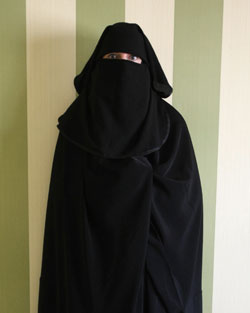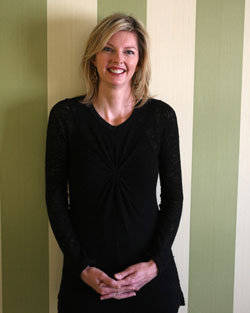Danielle Crittenden wore a burka for a week during her daily life in Washington, D.C. Click here to see a video of her experience, which appears in Canada's National Post. Click here to read Part One.
Part Two: Does This Burka Make Me Look Fat?
It looks like laundry day in a mourning Victorian household. I've got a large pile of black fabric in front of me, which I have to sort into cloaks, gloves and headcoverings.
Once separated, I have to figure out how to put them on. The cloak (abaya) seems straightforward enough: It could double as a vampire cape for Halloween. I find the armholes in the folds, and wrap the whole thing around my shoulders. It drapes down to my ankles. As I turn before the mirror, I notice goiter-like bumps at my hips. Oh great -- this is going to be even more flattering than I thought! But surely this can't be right?
Vexingly, there are no enclosed Ikea-like diagrams with cheerful balloon people, suitable for all languages. A search online turns up nothing helpful (keywords: burka abaya hijab how to wear). There are many sites that show you how to style a headscarf, but the abaya is taken for granted -- as in, only an idiot wouldn't know how to put it on.

I had opted (blithely, in retrospect) for the most conservative, Saudi-style of abaya (i.e. velcro not included). So I improvise: I pull the top part over my head, as if I'm about to run out in the rain, and then tuck in another piece under my left shoulder so the front stays closed, sort-of.
Then comes the niqab, or face-covering mask. Fortunately, the salesman at the Falls Church, Va., Islamoboutique showed me how to wear it; more fortunately, it uses Velcro.(:-D!). I wrap it around my head, fastening it over the cloth at the back. Then I flip back the outer two layers of veil to reveal the eye-slit.
The last uncovered parts of me are my hands -- which, as they move about my head, adjusting the mask, resemble the disembodied stars of a shadow puppet show. I pull on my gloves and stand up. The rest of my body vanishes under the lumpy folds of cloth. I've worn a black longsleeve t-shirt, yoga pants, and boots beneath the abaya (the closest thing I have in my wardrobe to colorless Arabic undergarments).
I take in the sight of me fully veiled for the first time. The emoticon for an Islamic woman in shock might be this: ( : ) ! To my Western eye, I look like Mrs. Darth Vader.
"Wow. Weird," says cameraman Brent Foster, when I unveil the veiled edition of myself. He is 25 and has already done assignments throughout the Middle East. The costume is not "weird" to him per se -- only the thought of someone like me inside it.
Brent will be my male companion for the next few days. He will discreetly record how I go about my daily life in Islamic dress and the reactions of people to me. More usefully, I quickly realize, he will be able to help me simply get around.
For one of the first things I notice is that I can't see my feet -- or really anything much below my nose -- unless I bend forward to look down, but then the mask slips up my face and blocks my eyes. Also, my peripheral vision is severely impaired. I have to turn my head like a whiplash victim to compensate for the "blind spots" on either side.

The worst part about the outfit, though, is the sudden shortage of oxygen. I assume it's not as bad, say, as would be pulling a plastic bag over my head. The fabric is, after all, "breathable." But the flow is definitely reduced; the mask flutters in front of my mouth as I gasp for air.
"I think you're going to have to drive." I hand the cameraman my car keys, a metal bundle festooned with grocery swipe cards and a cheezy plasticized photo of my youngest daughter posing with her favorite TV characters, the Power Rangers. (Maybe that's what I look like: an al-Jazeera version of the Black Ranger.)
As we go to the car, I notice my impulse is to hunch and shuffle as I walk. Part of this is because I need to gather up the cloak in front of me so I don't trip. But also, there is something psychological going on: as if the weight and constriction of the outer clothing constricts the personality on the inside too. I'm also trying to manage my purse, which I can no longer simply sling over my shoulder. When I sit down in the car, the abaya pulls even more and my mask slips. I shift around trying to settle everything while blindly fumbling for my seat-belt. Brent watches with bemusement.
"I think I need safety pins. Like, urgently."
"Sure, where can we get those?"
"The drugstore."
"Fine. Just tell me where it is."
As I give directions to my cameraman-turned-driver, I feel my first loss of real freedom -- having to be driven by someone else. It's not like being in a taxi or an airport limousine, or the luxury of having a private chauffeur. I'm sitting in my own car, in my own city, completely dependent upon the visitor I am ostensibly showing around.
This dependency is, in fact, quite true to life. If I were an Islamist woman living in the Middle East, I'd need a male escort like him whenever I emerged from the house (strictly speaking, he would have to be related to me). In Saudi Arabia, where women aren't permitted to drive at all, I would require his services full-time -- at least if I were to live anything resembling what I take for granted as a normal life.
But that, as I'd quickly discover, was about to go too.
Photographs by Brent Foster, National Post
TOMORROW: 'Why don't you just take it off?'